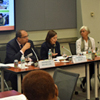Implementing the 2030 Development Agenda:
A Conversation on the Gender Dimension
Mahmoud Mohieldin Senior Vice President, The World Bank
Caren Grown Senior Director for Gender, The World Bank
Photos | Blog

Washington, DC—On March 22, 2016, Caren Grown, Senior Director for Gender at the World Bank, and Mahmoud Mohieldin, Senior Vice President for the 2030 Development Agenda, UN Relations and Partnerships, spoke before an audience of WFPG members and guests. They discussed how The World Bank Group is positioning itself to respond to the challenges of the Sustainable Development Goals (SDGs). Mohieldin summarized these challenges. Grown introduced the new World Bank Group Gender Strategy for 2016–2023. This strategy provides a road-map for borrowing countries who aspire to achieve the gender equality targets laid out in the SDG 5.
Mohieldin and Grown called on the international community to invest more in gender equality. Recent progress in reducing maternal mortality and girls’ education may seem impressive on average, yet they remain unevenly distributed across the globe. Mohieldin spoke of the need for increased sex-disaggregated data collection. Without it, the Bank cannot accurately evaluate projects nor measure progress. Part of that data collection process must involve providing people with unique identification. According to Mohieldin, there are 1.3 billion people without any form of identification. Only 22 of the 188 World Bank member countries have one unique form of identification. This will aid the Bank in understanding and serving the needs of its stakeholders.
Grown pointed out that in the past, women’s empowerment had primarily been seen through the light of improving human endowments such as education and health services. The Bank intends to continue its work on these areas. However, both Grown and Mohieldin emphasized that the Bank’s role in achieving SDG 5 is promoting women’s economic empowerment through the provision of better jobs, access to capital, and access to financial services. The Bank intends to harness technological developments, such as mobile phones, to reach women in remote areas. Kenya provides a promising example on this front. In Kenya, there is only a 7% gap between men and women in access to finance compared to the 9% gap globally and the 47% gap in Niger.
The new WBG Gender Strategy differs from the previous Gender Action Plans in that it includes recommendations to combat gender-based violence and redistribute care work. It also is the first Gender Strategy to apply to the entire World Bank Group. Grown said that the strategy was well-received at the UN Commission on the Status of Women meetings for its pragmatism. The strategy gives concrete targets and demands both policy experimentation and evidence-based practices. This marks a shift away from the previous gender mainstreaming methods. The strategy has also received praise for its focus on developing strong partnerships. Through examples from both the public and private sectors, Grown showed how the use of sex-disaggregated data can improve services and incentivize investment in women. Private sector partnerships can also create better jobs for women, stimulate growth among women-owned small and medium enterprises, and move women into positions of influence in the market. Mohieldin suggested that the Bank seek out partnerships with civil society as well.
The final pillar of the gender strategy is enhancing women’s voice and agency. Before constructing the gender strategy, Grown visited 22 countries to consult with women stakeholders. Though the Bank is not directly involved in national politics, it does promote women’s leadership on a project level. Grown cited the example of women serving in positions of leadership for water users associations connected with Bank sanitation projects. According to Grown, “when women are more than 30% of whatever governance body, whether it’s national government or a city council or a water user association, there are real effects on everything from the budget allocations to what services get provided.” Natasha Stott Despoja, Australia’s Ambassador for Women and Girls, agreed. She and other guests cited their experience as legislators as evidence for the need of a critical mass of women in positions of power. Ambassador Wonekha of Uganda spoke about her experience:
“There was a time when the government of Uganda wanted to get another World Bank loan for something. But, there was a pending loan to support maternity and child health that the government wasn’t paying attention to. The women members of parliament mobilized women and men and they refused to pass any other loan for government until the loan on maternity and child health was passed.”
The Ambassador’s story highlighted what Mohieldin referenced as one of the greatest challenges: translating aspirational targets into concrete country-level priorities and policies. Both the Gender Strategy and the SDG’s are country-led approaches. Progress on gender equality largely depends, according to Mohieldin, on the “level of coordination and ownership we are seeing at the country-level.” Grown and Mohieldin stressed that implementing the 2030 Development Agenda requires greater involvement and more investment from all parties.
|
|